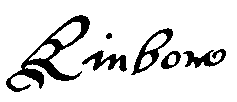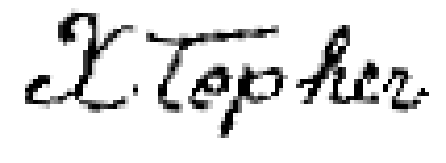Old forms of handwriting
 A
significant number of parish registers date back well into
the seventeenth century, and with any luck you may find
a set that go beyond the middle of the sixteenth. If you
do you must expect a little difficulty in deciphering the
hand writing in their earliest pages. Indeed many 19th century
documents quite difficult to decipher. In fact, at first,
the hand may seem quite in comprehensible, especially if
it was written in the seventeenth century. (example illustrated
to right: Zachariah) A
significant number of parish registers date back well into
the seventeenth century, and with any luck you may find
a set that go beyond the middle of the sixteenth. If you
do you must expect a little difficulty in deciphering the
hand writing in their earliest pages. Indeed many 19th century
documents quite difficult to decipher. In fact, at first,
the hand may seem quite in comprehensible, especially if
it was written in the seventeenth century. (example illustrated
to right: Zachariah)

 It is the letters and their combinations and abbreviations
in old handwriting, together with distortions caused by
an individual's style that are a source of difficulty to
the beginner. The more flowery the hand, the more difficult
to read. This is very evident when reading certain pages
of the 1841 South Australian Census in which every surname
is completed with a flourish that looks very much like an
's'. The accompanying dates illustrate problems with digits.
(example illustrated to right: Dalham)
It is the letters and their combinations and abbreviations
in old handwriting, together with distortions caused by
an individual's style that are a source of difficulty to
the beginner. The more flowery the hand, the more difficult
to read. This is very evident when reading certain pages
of the 1841 South Australian Census in which every surname
is completed with a flourish that looks very much like an
's'. The accompanying dates illustrate problems with digits.
(example illustrated to right: Dalham)

The principal source of difficulty in reading old handwriting
has to be the pairing of certain letters. Coupled with the
omission of the minor distinguishing features of individual
letters that may be missed by a hurried writer and we are
faced with problems! The adjacent place name demonstrates
the omission of a letter. In this case the omission is signalled
by a horizontal line which indicates that the omitted letter
will be an 'm' or 'n' and hence this word is Dalham. Abbreviations
are common and often inconsistent. May writers assumed that
the reader had knowledge of the topic and used self-created
abbreviations. (example illustrated to right: Kimborough)

Sorting out K and R; O and G and E; W and M; T and C; t
and c; G and C; u, n, m, and i; are probably the most difficult
of all. The old form of F (ff) is often rather like a modern
H. In the seventeenth century u and v are used almost indiscriminately.
The commonly used 'long s' which looks rather like an f
is still widely confused by transcribers. It appears at
the beginning of words and within them sometimes leading
to transcriptions like fight instead of sight. (example
illustrated to right: John)

When we add in the propensity to abbreviate words we just
add to the confusion. We are all familiar with shortened
words using the final letter in superscript form but many
other examples of abbreviations, some peculiar to a region
or individual writer exist. One classic form includes a
straight line over a letter to indicate the omission of
the letter m or n and a wavy line over a letter to indicate
the omission of several letters either before and/or after
the letter so designated! In the 16th and 17th centuries
a range of symbols were also used to represent abbreviations.
The  combination
of pr followed by a vowel produced some weird and wonderful
squiggles none of which seemed to have been used consistently!
(examples illustrated to right: papist and Christopher) combination
of pr followed by a vowel produced some weird and wonderful
squiggles none of which seemed to have been used consistently!
(examples illustrated to right: papist and Christopher)
There are a number of useful books that can assist and I
find that sharing the problem with others often produces
a result. Try coming back at a later date. Search the page
for similar letter combinations in other words. Sometimes
enlarging the text with a photocopier helps. Trace the enlarged
word with a pencil and you may come up with a result! I
find the following books to be helpful aids because they
give numerous excellent examples...
WSB Buck, Examples of handwriting 1550-1650, Soc
of Genealogists Lionel Munby, Reading Tudor and Stuart handwriting,
Phillimore.
Graham Jaunay BA DipT MACE AAGRA
Top down: Zacharia; Dalham; Kinborough;
John; papist; Christopher
|